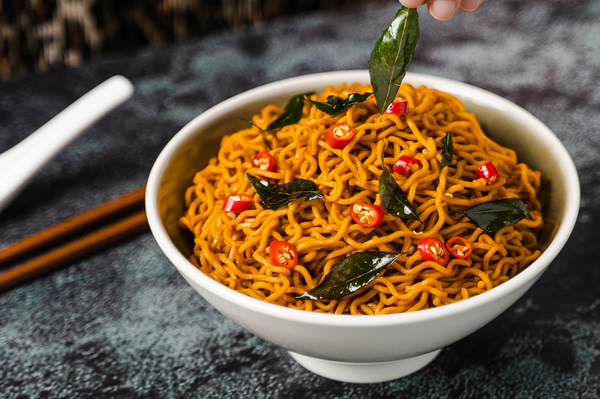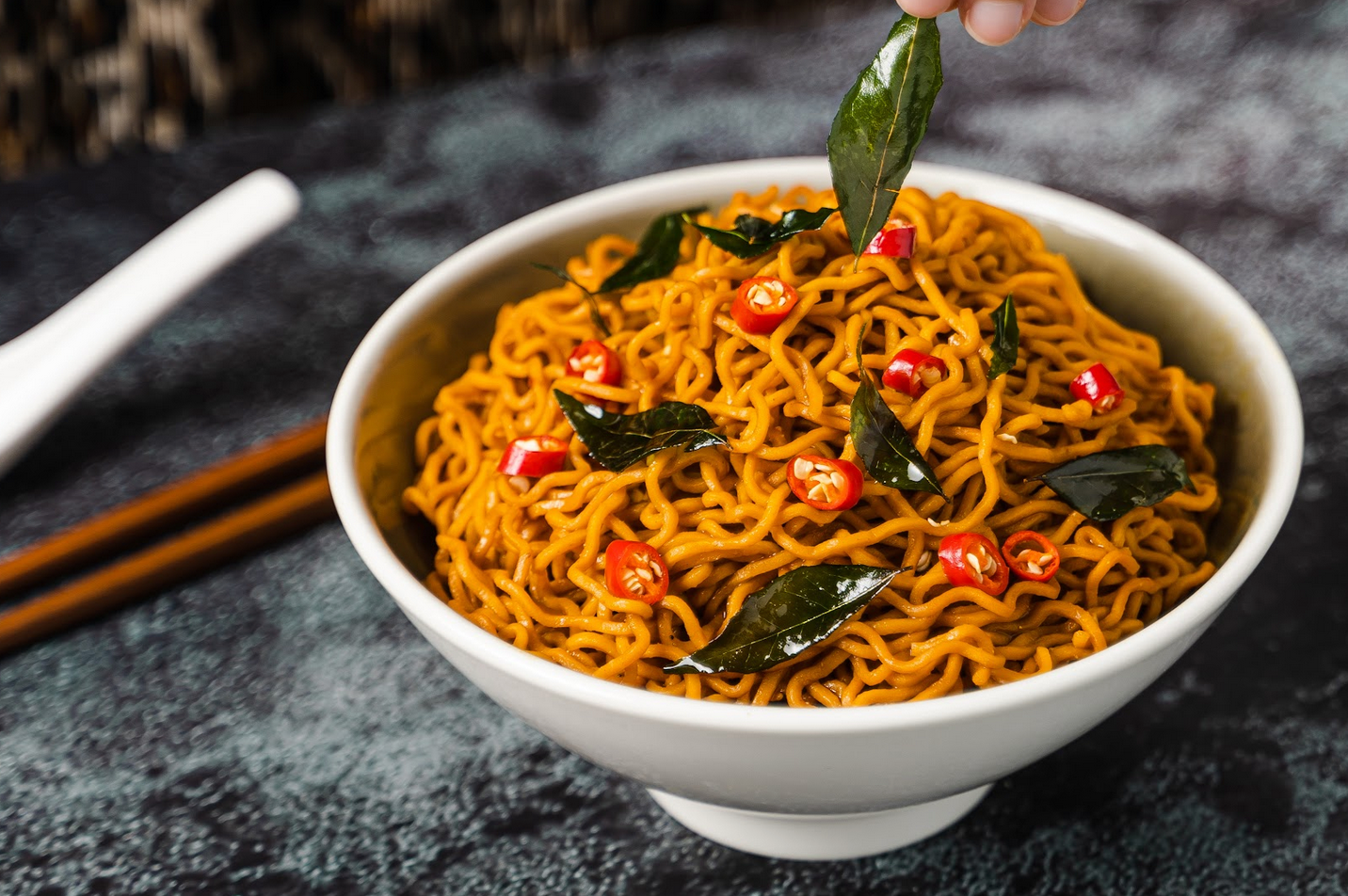What if...instant noodles were made this way?
Known as the poor college students’ main source of food, instant noodles have been satisfying the hungry bellies of the economically-unstable or culinarily-challenged for decades. However, the instant noodle has never been viewed as a nourishing food item-that is, until some of us asked what if…?
Magic Ramen!
The idea for the world’s first instant noodle, “chicken ramen,” (or more accurately ‘chikin ramen’) came to Momofuku Ando in 1940s post-war Japan. Still in recovery from WWII, Japan was facing nation-wide famine and its worst harvest season in decades. People were starving and dying, leaving them to rely heavily on wheat provided by the U.S during its occupation in Japan. Often made from this surplus of wheat were ramen and gyoza— a staple “stamina food,” both filling and high in calories. Despite this, the government pushed to produce bread instead, baffling Ando. As a means to maintain Japan’s heritage and possibly solve Japan’s hunger problem, he thought of making instant ramen that was not only more accessible, but also easier to prepare.
After a year of experimenting, Ando came up with an entire process of industrially manufacturing instant ramen— a process that is still implemented today. It starts with noodle-making, followed by steaming, seasoning and finally dehydrating the noodles by deep frying. Before long, people began calling the invention “Magic Ramen” for its convenience and ingenuity.
Sustenance vs subsistence
It has now been decades since the end of WWII. Japan’s economy is nowhere near where it used to be— but its instant noodle consumption has only increased. Japan consumes about 5,630 million servings of instant noodles a year and consumption increases by 100 thousand servings annually. Our diets have, slowly but surely, evolved from eating to obtain energy to survive, to eating for long-term health, wellness and prosperity. We are becoming more health-conscious by the day. Which begs the question— why is our instant noodle consumption increasing when we now value health over mere subsistence?
Empty calories aplenty
Nowadays, instant noodles are constantly associated with the term ‘empty calories.’ For those unfamiliar, empty calories are, fundamentally, foods that may be filling but have no nutritional value. It was a concept first explored by French physiologist François Magendie, who conducted an (ethically questionable) experiment in which he fed a 3 year-old dog only sugar and recorded his findings— it died in 32 days.
Although our diets are (hopefully) not as extreme as Magendie’s test animals’, we, especially children, still consume a notably high amount of empty calories— with the majority of it coming from added sugars, solid fats, processed oils and starch. Unfortunately, the introduction of instant noodles has done little to nothing to help ease its consumption.
Did eating the instant noodles leave you hungrier, quicker?
To answer this question, let’s take a look at the ingredients list many of us often ignore. Most instant noodles are made with a milled, refined and bleached version of wheat flour. During the refining process, the most nutritious parts of whole grains, like bran and germ, are removed— stripping the flour of most of its natural nutrients including: fibre, vitamins, iron, magnesium, phosphorus, and more.
Nevertheless, there is one thing wheat flour doesn’t lack in— carbohydrates. High intakes of carbohydrates, especially highly-processed carbs, are detrimental to our hormonal systems as it encourages the secretion of insulin. This consequently causes more energy to be converted into fat tissues instead of it being used to fuel other parts of the body. Which, in turn, causes hunger and overeating— leading to weight gain and obesity.
Busy office workers or students consume instant ramen to satiate their hunger and to feel energized but what they don’t realize is that it could leave them feeling even more hungry than they were before. What’s more surprising is that, being overweight and consuming junk food might not be as clear of a cause-and-effect situation as we once thought it to be. Feeling constant hunger and fatigue may even be symptoms of being overweight rather than its cause. It’s a simple but vicious cycle.
The ‘instant’ in instant noodles
Instant noodles get its ‘instant’-ness by being deep fried in palm oil prior to packing. Palm oil is a type of vegetable oil that is harvested from the fruit of oil palm trees. It’s relatively cheap and is usually available in huge amounts— but, like all things, it comes with a cost. Tropical forests and multitudes of ecosystems have been destroyed to make room for oil palm plantations. So much so that it has led to the imminent extinction of rhinos, elephants, tigers, and more— whose habitats have been destroyed. Not only is it destructive to the environment, palm oil is high in saturated fats which boosts LDL cholesterol and triglycerides, leading to higher risks of heart disease.
What doesn't kill you makes you... keep eating it?
Despite countless studies illustrating the harm of instant noodles, the world still slurps down 116.6 billion servings a year; which means almost 320 million servings daily. Consumption is most prominent in Asia—where almost 80% of the world’s instant noodles are eaten. It seems that the majority of us consume instant noodles despite the health risks.
Originally invented as a solution to mass hunger, the instant noodle is now considered to be a favourite ‘comfort food’ for many. It is a warm, nostalgia-filled bowl that’s easy to whip up in no time. Many of us are guilty of stuffing a few packets in our luggage for a taste of home when we travel. It’s clear that instant noodles aren’t going anywhere soon despite our society transitioning to more health-conscious diets and lifestyles. So, what can we do about it?
What if we could make instant noodles healthy?
This is the fundamental question that our founders targeted as they deep dived into a five-year R&D project.
While WhatIF Foods believes that instant noodles will continue to play a central role in bringing accessible calories to people, we believe that we and our consumers must try to REimagine the instant noodle category for the sake of our health and the Earth’s health. Years of R&D later, we have developed proprietary technologies to make instant noodles nourishing for you, while regenerating our environment and farming communities.
Not deep-fried like the other guys
WhatIF Foods has our very own patented air-frying process that allows for noodles to be pre-cooked without having to be deep fried— making it palm oil-free and less fatty. Air-frying also helps our noodles retain nutrients and natural colours from the regenerative crops used in our unique formulations.
Speaking of Regenerative Crops...
Regenerative Crops are nutritionally dense crops that are climate-resilient, resource efficient, and economically viable for smallholder farmers. We feature the BamNut, traditionally known as Bambara groundnut or Kacang Poi (Bahasa), in all our noodles. As our noodles are not exposed to high temperature associated with the deep-frying process, we manage to retain all the natural goodness of the BamNut like its high protein and fiber content. As a result, all our noodles are high in protein and contain a significantly higher amount of fibre compared to others on the market.
Fooling the brain
The food science team at WhatIF Foods searched high and low for the best way to bring out that fried flavour without the need for deep-frying. Much of the flavour of traditional instant noodles that we all love come from an abundance of artificial flavouring, MSG, and the deep-frying of the noodles. We took on the challenge to eliminate all these nasties. Our team finally arrived at a ‘secret sprinkle’ of herbs and spices, which is 100% natural to create noodles that fool your brain into thinking that you are eating something deep-fried even when it is not!
Where can I find WhatIF Foods noodles?
Starting on the 1st of July, our four colourful noodles - BAMnut Noodles with Sweet Hot seasoning, BAMnut Moringa Noodles with Sesame Garlic seasoning, the BAMnut Pumpkin Noodles with Cheeky Curry seasoning, and the BAMnut Charcoal Noodles with Shroom Pepper seasoning - will be available on our webpage and 28 locations of FairPrice Finest. Support us in our journey in reimagining instant noodles.
What's next?
Read all about the mighty BAMnut and its journey to your kitchen here.
Learn more about the show-stopping nutritional profile of BAMnut here.
Discover how biochar plays an important role in reducing our carbon footprint here.
Find out how we create a Better Better with our partner farming communities here.
References:
C;, Bautista LE;Herrán OF;Serrano. “Effects of Palm Oil and Dietary Cholesterol on Plasma Lipoproteins: Results from a Dietary Crossover Trial in Free-Living Subjects.” European Journal of Clinical Nutrition, U.S. National Library of Medicine, Sept. 2001, pubmed.ncbi.nlm.nih.gov/11528488/.
“Global Demand.” Global Demand | World Instant Noodles Association., 11 May 2021, instantnoodles.org/en/noodles/market.html.
Reedy, Jill, and Susan M Krebs-Smith. “Dietary Sources of Energy, Solid Fats, and Added Sugars among Children and Adolescents in the United States.” Journal of the American Dietetic Association, U.S. National Library of Medicine, Oct. 2010, www.ncbi.nlm.nih.gov/pmc/articles/PMC3428130/.
Utarwuthipong T;Komindr S;Pakpeankitvatana V;Songchitsomboon S;Thongmuang N; “Small Dense Low-Density Lipoprotein Concentration and Oxidative Susceptibility Changes after Consumption of Soybean Oil, Rice Bran Oil, Palm Oil and Mixed Rice Bran/Palm Oil in Hypercholesterolaemic Women.” The Journal of International Medical Research, U.S. National Library of Medicine, Feb. 2009, pubmed.ncbi.nlm.nih.gov/19215678/.
“What Is Palm Oil? Facts About the Palm Oil Industry.” WWF, World Wildlife Fund, www.worldwildlife.org/industries/palm-oil.
Yeoh, Grace. “Are Healthier Instant Noodles Really Healthy? After the Hype Come the Checks.” CNA, 23 Dec. 2020, www.channelnewsasia.com/news/cnainsider/healthy-instant-noodles-hype-fad-reality-check-marketing-gimmick-13081554.






